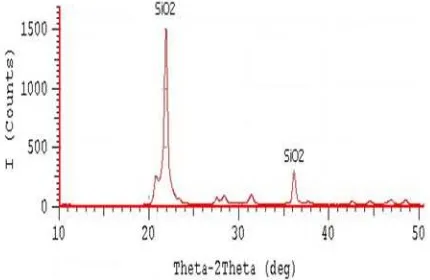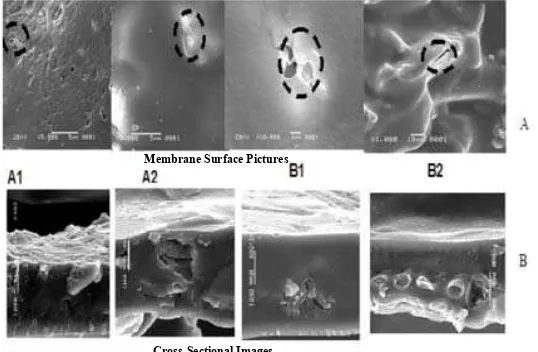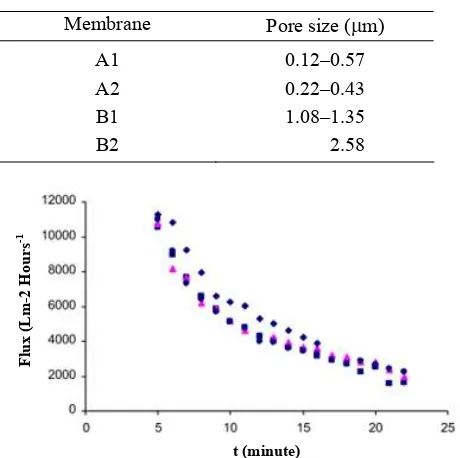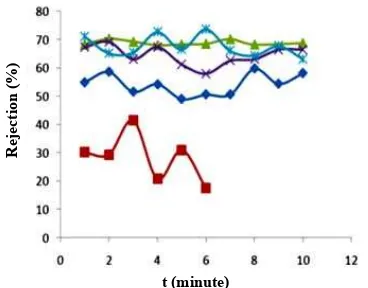Adsorption of Waste Metal Cr(VI) with Composite Membranes
(Chitosan-Silica Rice Husks)
Fifia Zulti
1*), Kiagus Dahlan
2, and Purwantiningsih Sugita
31.Research Center for Limnology, Lembaga Ilmu Pengetahuan Indonesia, Cibinong 16911, Indonesia 2. Departmen of Physic, FMIPA, Institut Pertanian Bogor, Darmaga, Bogor 16880, Indonesia 3. Departmen of Chemistry, FMIPA, Institut Pertanian Bogor, Darmaga, Bogor 16880, Indonesia
*)
E-mail: fifia.zulti@limnologi.lipi.go.id
Abstract
Chromium compounds are widely used in modern industry. Many of these compounds are dumped into the surrounding environment. Membrane technology is more efficient and effective than conventional methods for waste treatment. The research objective was to make a membrane separation process that can be applied to Cr(VI). Membranes were made from chitosan and silica rice husks. Variations of chitosan and silica rice husk used (g) are 2:1 (A1), 2:2 (A2), 3:1 (B1), and 3:2 (B2). The membrane was made by using an inverted phase technique. Results of SEM characterization of membranes showed that B2 has the largest pores at 2.58 μm. The FTIR characterization results indicate the presence of crosslinking between chitosan with silica rice husk with the appearance of Si-O adsorption band at wavelength 1122-980/cm. A1 membrane, with the smallest pore size has the greatest rejection value towards Cr(VI) which is 70%. The result of this research showed that the composite membrane of silica rice husk was effective enough to adsorb metal Cr(VI) with an average adsorption capacity of 1665.85 mg/g.
Abstrak
Penyerapan Limbah Logam Cr(VI) dengan Membran Komposit (Kitosan-Silika Sekam Padi). Senyawa kromium
banyak digunakan dalam industri modern. Senyawa tersebut banyak dibuang begitu saja ke lingkungan sekitar. Teknologi membrane lebih efisien dan efektif dari pada metode konvensional untuk pengolahan limbah. Tujuan penelitian adalah membuat membran yang dapat digunakan dalam proses pemisahan Cr(VI). Membran dibuat dari kitosan dan silika sekam padi. Variasi kitosan dan silika sekam padi yang digunakan (g) adalah 2:1 (A1), 2:2 (A2), 3:1 (B1), dan 3:2 (B2). Membran dibuat dengan menggunakan teknik inversa fasa. Dari hasil karakterisasi SEM diketahui bahwa membran B2 mempunyai pori yang paling besar yaitu 2,58 μm. Hasil karakterisasi FTIR menunjukkan adanya ikatan silang antara kitosan dengan silika sekam padi dengan munculnya pita serapan Si-O pada bilangan gelombang 1122-980/cm. Membran A1 dengan ukuran pori paling kecil mempunyai nilai rejeksi terhadap Cr(VI) paling besar yaitu 70%. Penelitian menunjukkan bahwa membran komposit-silika sekam padi cukup efektif untuk menyerap logam Cr(VI) dengan kapasitas adsorpsi rata-rata adalah 1665.85 mg/g.
Keywords: chitosan, Cr(VI), membrane, silica rice husk
1.
Introduction
The increase in industrial activity in Indonesia has had an effect on increasing environmental pollution. Pollution of water, air, soil and the disposal of hazardous and toxic waste (B3) is a problem that must be faced by communities living around the industrial area. Heavy metals, a type of B3 waste, are toxic and carcinogenic [1]. Metal Cr(VI) is a heavy metal that is commonly found in electroplating industrial waste and is hazardous to health and the environment.
this study, composite membranes made of chitosan are mixed with silica rice husk.
Rice husk is an abundant material because Indonesia is a country that produces rice husks. The rice husks contain silica. Based on research conducted, the content of silica (SiO2) in the rice husk is quite high, ranging from 87-90% [6].
Chitosan is a polymer that has been widely used as a membrane material. Chitosan has the ability to adsorb metals by forming complexes with metals so chitosan can be used to treat waste metal [7]. Chitosan membrane has a dense structure so it has very small porosity. For that reason chitosan is combined with silica to form pores that are more effective in screening waste. Particles of silica are ideal porogens for producing porous chitosan membranes with controlled porosity and good mechanic properties [8].
The purpose of this research was to make membrane filtration from chitosan composited with silica rice husks. Furthermore, the membrane is tested for its ability to adsorb metal Cr(VI) from artificial waste.
2. Methods
The main materials used in this study were rice husk and chitosan. Rice husk is taken from the rice mills around IPB at Darmaga campus. Chitosan was purchased from the Fisheries Faculty of the Department of Technology, IPB, with 74.25% degree of deacetylation.
Making silica rice husk was conducted in three stages i.e. drying, incinerating and acidification Pre-dried rice husks were washed with distilled water and then dried at 190 oC for 1 h in a furnace. Then the husks were incinerated at a temperature of 300 oC for 30 minutes, and 600 oC for 1 h. Once charcoal had formed it was heated again at a temperature of 600 oC for 1 h to become ash. The next process is acidification with HCl (37%) and more heating at a temperature of 1000 oC for 6 hours [9].
Preparation of composite membranes. The inverse
phase technique was used. Chitosan was dissolved in 50 ml of 2% acetic acid solution and sonicated for 1 h. Then, the silica particles were gradually added to the chitosan. The solution was further sonicated for 1 h to make a homogeneous solution. Sonication was performed at a frequency of 42 kHz with a Bronson 2510 which breaks down the molecules so that they dissolve faster. The solution was then filtered, then shaped in the membrane mold and dried at 50 oC for 12 h in an incubator. After drying, the membrane was soaked in a solution of NaOH (5%). Membranes were further heated for 2 h at a temperature of 80 oC to
remove silica and produce a porous chitosan membrane. The membrane was washed again with distilled water to remove residual NaOH. The modification made from previous studies [9-10] was the use of chitosan and silica rice husk mass composition. Variations in composition were performed to make membranes with the best pores to filter waste. In making this membrane the various mass compositions (g) of chitosan and silica rice husk used are: 2:1 (A1), 2:2 (A2), 3:1 (B1) and 3:2 (B2).
Test of flux and membrane rejection. Determining
water flux and waste rejection is obtained by measuring the amount of permeate volume that passes through a unit of membrane surface per unit area per unit time. The waste used is artificial wastewater obtained by dissolving K2Cr2O7 in distilled water with a concentration of 300 ppm. The rejection coefficient (R) can be calculated using the following equation [11]:
%
3.
Results and Discussion
Characterization of silica rice husk using XRD and FTIR. Heat at a temperature of 1000 oC produces silica rice husk in the form of crystals. Figure 1 depicts two silica peaks (SiO2) at an angle of 2θ at 22o and 36o with quite high intensity. Referring to the XRD analysis research by Handayani [9], peaks also appear with high intensity at 2θ at 22o and 36o. The degree of crystallinity formed was 75.98%. The type of crystal formed can be determined by calculating the parameters of the crystal lattice by a value of 2θ. Lattice parameters can be determined by determining the value of a, b, and c. The XRD results of silica rice husk in Figure 1 have lattice parameter values of a = b ≠ c with α = = = 90°,
Figure 1. X-rayDifraction (XRD) Analysis of Silica Rice
therefore the dominant type of crystal formed at heating temperature of 1000 oC is -crystobalite with tetragonal crystalline structure.
The IR spectra of silica rice husk in Figure 2 show the appearance of a sharp peak of Si-O functional group at wavelengths of around 1055/cm. Si-O functional group is a characteristic of the silica compound. Moreover, the groups of O-H, Si-C and Si-Cl also appear at wavelengths 3371/cm, 820/cm, and 471/cm respectively.
Analysis of functional groups membrane. Functional groups that appear in membranes A1, A2, B1 and B2 have transmittance intensity similar to the sharp peaks in the adsorption band of each group function. Figure 3 shows the emergence of functional groups on the Si-O wavelength of around 1055 and 1122-980/cm. The Si-O adsorption band of the membrane appears around the wavelength range 1122-980/cm indicating a cross-link between chitosan and silica rice husk. Si-O wave length that appears in membranes A1 (1110/cm), A2 (1092/cm), B1 (1122/cm) and B2 (1118/cm) is greater than the value of the Si-O wavelength on silica rice husk (1055/cm.) This indicates a shift in the Si-O adsorption band due to a hydrogen bond between the functional groups of Si-O silica rice husk with the O-H chitosan group.The hydrogen strengthens the link between silica rice husk with chitosan, but causes the Si-O bond to be shortened so that the Si-O bond becomes stronger and the vibrational energy bond becomes greater. Based on the plank equation (E=h.c.ν), the wave length is proportional to the energy (E), so the increase in energy will make the adsorption band shift towards a greater wavelength (ν).
Morphological analysis of membrane. The membrane
formed is porous. The porous membrane is formed due to the influence of the silica composition. The pore shapes formed area symmetrical and the pore size is not homogeneous, see Figure 4.
Pore size of the membrane that forms varies depending on the composition of chitosan and silica (Table 1). A2 membrane has a larger pore size than membrane A1 because A2 added as much as 2 grams of silica while A1 has only 1 gram of silica. Similarly, for the B membranes, B1 has bigger sized pores compared to B2 which as more silica than B1. So the addition of silica will increase thepore size of the membrane formed. The
Figure 2. FTIR Spectra of Silica Rice Husk
Figure 3. FTIR Spectra of Chitosan-Silica Rice Husk Membranes A1, A2, B1, and B2
Figure 4. Result of SEM Membrane as Seen from (A) Surface, (B) Cross-Section Wave Number (Cm-1)
Tra
n
smitta
nce (
%
)
Wave Number (Cm-1)
Membrane Surface Pictures
Table 1. Membrane Pore Size
results are consistent with previous research by Liu et al. [10] that states that silica serves as a porogen, meaning the particles of silica form pores in the chitosan membrane. This research revealed that the mass ratio of silica/chitosan is 10:1 (g), the membrane pore size on average is 25-35 μm.
Flux membrane. In Figure 5 it can be seen that in
minute10 the flux sharply declined until minute 22. If screening is continued the flux values continue to fall until they almost reach zero. Decline in the flux value is due to membrane fouling. The direct effect of fouling causes a decrease in permeated flux, while the long-term effect can cause irreversible fouling of the membrane material and reduce its lifetime [12]. In this condition the membrane begins to clog up, thus affecting the amount that permeates the membrane.
The flux test results showed that membrane A1 produces a maximum flux value of about 50,000 Lm/m2hour in 300 ppm potassium dichromate (artificial waste). The value decreases within creasing flux time. At 10 minute the flux value is almost constant until 20 minute. This indicates clogging in the membrane called fouling. The maximum flux value of membrane A2 in artificial waste is around 60,000 Lm/m2hour. This flux value is higher than the A1 membrane. This indicates that membrane A2 has larger pore sizes. The A2 membrane has a chitosan:silica composition of 2:1 whereas the A1 membrane composition is 2:2. An increased amount of silica in the membrane causes larger pore size and consequently a greater flux value.
Likemembrane A1, fouling of A2 membrane begins at minute10.
Flux values of membranes B1 and B2 are not too different from membranes A1 and A2 as shown in Figure 3. Fouling also occurred in 10 minute marked by an increase of flux values that almost fell to zero at minute twenty. The average values of the artificial waste flux on membranes are in sequence 9,192.46 Lm/m2hour; 8,788.74 Lm/m2hour; 8,460.25 Lm/m2hour, and 2,403.77 Lm/m2hour respectively for membranes A2, A1, B1 and B2. Membrane flux values are also influenced by the degree of membrane swelling. When the feed concentration permeates membrane A2 it opens pores thereby increasing pore size thus causing swelling.
Membrane rejection. In the A1 membrane, as can be
seen in Figure 6, the rejection value does not vary significantly from the screening waste process. The average value of membrane rejection for A1 is 70%. The average concentration of the final solution of Cr(VI) after being filtered by membrane A1 is 90.12 ppm. The average rejection value of membrane A2 is 66.18%, which is less than membrane A1. The final concentration of Cr(VI) after being filtered by membrane A2 is 101.47 ppm. The average rejection of B1 membrane is 67.55%. The average final concentration of Cr(VI) after being filtered by membrane B1 is 97.35 ppm, while after being filtered by membrane B2 it is 101.48 ppm.
In Figure 6 it can also be seen that the chitosan membrane without silica is capable of holding metal Cr(VI) to a maximum of 41.37%. Chitosan can act as an adsorbent as it is able to bind the metal. However, the rejection value is still small because the chitosan membrane without silica is dense so its pores are very small compared to if it has the addition of silica. So, of the four membranes that have been tested, based on rejection ability the average is 70%, 66.18%, 67.55%, 55.32% and 30.50% for membranes A1, A2, B1, B2 and chitosan for separation within 22 minutes. A1 membrane with smaller pore sizes than membranes A2, B1 and B2 has the highest rejection value of metal Cr(VI) which is an average of 70%, meaning that only 30% of the metal membrane Cr(VI) can escape. This value is greater than the metal uptake of Cr(VI) with the ion exchange membrane cell method at the amount of 30% for 300 minutes [13]. The results of research by Devaprasath et al. [14] using spicigeraprosopis plant leaves also has a Cr(VI) percentage adsorption of about 69.4%.
The mechanism of metal adsorption that occurs between the membrane composite of chitosan with silica rice husk is supported by the nature of chitosan as a polycationic polymer. Chitosan is a chelating polymer
t (minute)
Flux (Lm-2
Hour
s
derived from natural ingredients so that chitosan is able to bind metals to form a metal-chitosan complex. Chitosan is an excellent ion chelating agent. Electrons of nitrogen contained in the amine group can form covalent bonds with transitory metal ions, including chromium. Chitosan acts as an electron pair donor in the transition of metal ions in the formation of a metal-chitosan complex. While silica, in addition to forming pores in the membrane is also thought to act as a metal adsorbent of Cr(VI). This is evidenced by the increased rejection value of Cr(VI) on the chitosan membrane composited with silica compared with the chitosan membrane without the addition of silica rice husk.
Average adsorption capacity of chitosan-silica rice husk composite membrane is 1665.85 mg/g. When compared with the results of research by Vijaya et al. [15], the adsorption ability of chitosan with silica rice husk composite is greater than adsorbent chitosan coated with a commercial silica which is 294.1 mg/g.
Kinetic adsorption. Determining the reaction rate (k) is calculated using the first-order and second-order kinetic model [16]. According to Table 2 the adsorption of Cr(VI) with chitosan-silica rice husk membrane followed
Figure 6. Value of Chitosan Membrane Rejection, A1, A2, B1, and B2 on the Artificial Wastewater; Chitosan (■), A1 (c), A2 (X), B1 (½), B2 (♦)
Table 2. First Order and Second Order Kinetic Model of Cr(VI) Adsorption with Chitosan-Silica Rice Husk Membrane (linear). The k values obtained in this study illustrate that the greater the reaction rate constant is the faster is the depletion of reactants.
4. Conclusions
This study has created a composite membrane with chitosan and silica rice husk. Composite membrane can be used as membrane filtration for separating Cr(VI) metal. Based on the results of this study it can be concluded that the addition of silica rice husk in the manufacture of chitosan membrane affects the pore size of the membrane. Chitosan and silica rice husk form cross-links as indicated by the appearance of the Si-O adsorption b and at wavelength 1122-980/cm. SEM characterization results show that membrane B2 with 3 gram of chitosan and 2 grams of silica has the greatest pore size. A1 membrane with mass ratio 2:1 produces a smaller pore size and more effectively eliminates the metal Cr(VI) compared to other membranes with a rejection value of 70%. The average adsorption capacity of chitosan-silica rice husk membrane is equal to 1665.85 mg/g with the adsorption rate following the second-order kinetics model.
Acknowledgement
The authors would like to thank LIPI Competitive Scholarship Batch II (2008-2010) for funding this research.
References
[1] G. Gosh, P.K. Bhattacharya, Chem. Eng. J. 119 (2006) 45.
[2] J. Wu, H. Zhang, P.J. He, Q. Yao, L.M. Shao, J. Hazard. Mater. 176 (2010) 697.
[3] H. Gao, Y. Liu, G. Zeng,W. Xu, T. Li, W. Xia, J. Hazard. Mater. 150 (2008) 446.
[4] P.L. Hariani, N. Hidayat, M.J. Oktaria, J. Penelitian Sains 12.2C.(2009) 1 (in Indonesia).
[5] M. Lindu. J. Teknologi Lingkungan 4 (2008) 4 (in Indonesia).
[6] A.L. Putro, D. Prasetyo, Akta kimindo 3 (2007) 33.
[7] Meriatna, Thesis, Universitas Sumatera Utara, Medan, 2008 (in Indonesia).
[8] X.F. Zeng, E. Ruckenstein, Ind. Eng. Chem. Res. 35/11 (1996) 4169.
[9] E. Handayani, Tesis, Sekolah Pascasarjana Institut Pertanian Bogor, Bogor, 2009 (in Indonesia).
[10] J. Liu, X. Chen, Z. Shao, P. Zhou, J. Appl. Polym. Sci. 90 (2003) 1108.
[13] A. Tor, T. Buyukerkek, Y. Cengeloglu, M. Ersoz, Desalination 171 (2004) 233.
[14] P.M. Devaprasath, J.S. Solomon, B.V. Thomas, J. Appl. Sci. Environ. Sanitation 2/3 (2007) 77.
[15] Y. Vijaya, M.V. Subbaiah, A.S. Reddy, J.A. Priya, A. Krishnaiah, Indian J. Phys. Chem. 5 (2010) 22.



